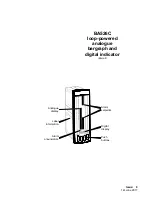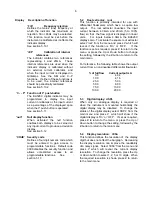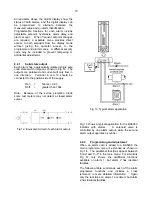
4
2.1
Controls
The BA526C is controlled and calibrated via four
front panel push-button switches.
In the display
mode i.e. when the instrument is displaying a
4/20mA input current, these switches have the
following functions:
P
While this button is pushed the digital
display will show the input current in
mA, or as a percentage of the
instrument span depending upon how
the instrument has been programmed.
When the button is released the normal
display in engineering units will return.
The function of this push-button is
modified when either alarm is enabled.
Down
While this button is pushed the digital
display will show the calibration with a
4mA input. When released the normal
display in engineering units will return.
Up
While this button is pushed the digital
display will show the calibration with a
20mA input.
When released the
normal displays in engineering units will
return.
E
No function in the display mode.
3.
APPLICATIONS
3.1
Transmitter loops
A BA526C indicator may be connected in series
with almost any 4/20mA current loop that can
tolerate the 1.1V drop required to operate the
instrument (increases to 1.2V at -20ºC), and be
calibrated to display the measured variable or
control signal in engineering units.
Fig 2 illustrates a typical application in which a
BA526C indicator is connected in series with a
2-wire transmitter.
Fig 2 BA526C in a transmitter loop
Considering the example shown in Fig 2, the sum
of the maximum voltage drops of all the
components in the loop must be less than the
minimum power supply voltage.
Therefore at 20mA the power supply in this
example must have an output greater than 16.6V
Minimum operating voltage of 2-wire Tx
10.0
Maximum voltage drop caused by controller
5.0
Maximum voltage drop caused by BA526C
1.2
Maximum voltage drop caused by cables
0.4
______
16.6V
Summary of Contents for BA526C
Page 11: ...11 ...



















